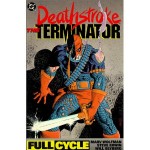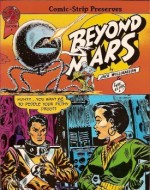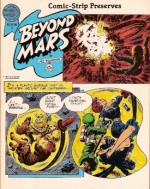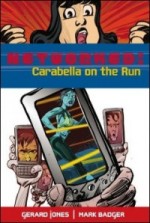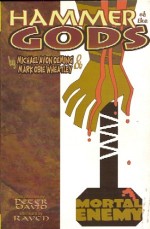
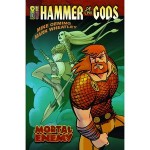
By Michael Avon Oeming & Frank Cho, (Image/IDW)
Image ISBN: 978-1-58240-271-0, IDW ISBN: 978-1-60010631-6
Mythology has always inspired our fantasies and is never far from our popular culture: just take a look at TV shows like Hercules: the Legendary Journeys and Supernatural or books and films such Clash of the Titans and Percy Jackson and the Lightning Thief which again reinvented and expanded the ancient tales for a new generation.
At the turn of this century all-rounder Michael Avon Oeming re-imagined the Norse tales which had already been so thoroughly exploited by Marvel (and even tangentially by DC in the splendid Arak, Son of Thunder series) to produce an outrageously addictive post-modern take in the five issue miniseries Hammer of the Gods. He was thoroughly aided and abetted by co-plotter, inker, letterer and colourist Mark Wheatley – a veteran comics maker who has been criminally undervalued for decades (see for example the staggeringly impressive Breathtaker to glean what I mean).
The lands of the far North are hard and cold and unforgiving, just like the gods that rule over them. In ‘Hammer of the Gods’ a peasant couple stand the deathwatch for their newborn son who will not survive the night, when a stranger comes seeking shelter from the icy storms. She is welcomed even though old Tyr and Gerda have nothing…
Delighted to finally find mortals who keep the old ways of hearth and hospitality the fierce warrior woman rewards them by blessing their child. He will live, growing strong and wise. Moreover he will possess the strength of the gods so long as he never wields a weapon. Knowing he will thrive the couple finally name their boy: “Modi†which means both Courage and son of Thorr…
The boy grows strong enough to topple trees with a blow and carve wood without a blade and becomes devout in the worship of the Thunder God he is named for. Because he will not fight the other village children constantly pick on him, but Modi is patient as well as strong…
When mature he becomes a globe-girdling explorer. After years he returns to his birthplace only to find the village destroyed by giants and monsters that have escaped from bleak Jotunheim to plague the Earth. Realising his beloved deities have done nothing to save his family or people, Modi swears a mighty oath and denounces the gods forever. Easily slaying the Frost Giant which destroyed his village, Modi pledges to walk the world until he has made the negligent gods pay for abandoning the devoted charges in their care…
Modi’s epic voyages begin in ‘Entrance to Valhalla’, as he roams the cold world destroying beasts and devils, recruiting like-minded men to his crusade. Soon he leads an army of hardened warriors embittered and disillusioned by the disdain and delinquency of their gods.
United together they eradicate the magical horror that plagues mankind, but it is never enough: what Modi wants is a confrontation with the gods themselves…
In ‘Falling For Gods!’ he first battles and then allies himself with Skögul, a fallen Valkyrie who shares his opinions, but when the trickster god Loki also tries to join them she preaches caution. Why would any overlord of Asgard offer them a free pass to Valhalla and their longed-for meeting with the absentee immortals? They refuse the overture and wander the world together, growing ever closer as they seek another way to storm the stronghold of the gods…
Eventually they find a way and enter Asgard for ‘The Final Battle’ only to receive a terrible shock: the magic hammer of Thorr has lost its power and the gods are old and broken men, helpless before the constant onslaught of the giants and demons of Ragnarok.
Much as he despises gods Modi hates giants more and soon he is whittling the frozen horde down to size, but even his might is not inexhaustible. Only a miracle can save him and all the lands of humanity…
This is a rousing rollercoaster ride of sheer adventure beautifully illustrated and magically compelling, with just the right touch of worldly cynicism and passionate mystery to fire up any reader who thinks they’ve seen all that can be done with these hoary old themes.
The book (which was re-issued by IDW in 2009) also includes text pieces from Peter David, WWE star Raven, Oeming and Wheatley, plus development sketches, front and back cover designs, pencil drafts, privately commissioned artworks and cover images and illustration art by Adam Hughes, Frank Cho and Dave Johnson.
™ Michael Avon Oeming and © 2002, 2009 Michael Avon Oeming & Mark Obie Wheatley. All Rights Reserved.

